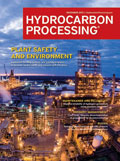
November 2015
Special Report: Plant Safety and Environment
Although simulators have been deployed widely in process industries, unique thermodynamic and physical phenomena are involved in the process that made modeling such systems very difficult in the past.
This article describes the strengths and weaknesses of various tracking technologies and their efficacy in a metallic equipment environment.
Regional Report
Russia’s potential for a robust downstream sector stems from the country’s enormous oil and gas resources.
Catalysts
To prevent deactivation, the latest generation of polymerization catalysts requires removal of a wide range of contaminants to ultra-low levels in the monomer, comonomer, solvent and reaction-controlling gas streams in polyolefin production processes.
Environment and Safety
Initial mercury management strategies began in 2010 at a US refinery processing approximately 200 Mbpd of North Slope crude oil.
Maintenance and Reliability
Through this plant study, a licensor demonstrates effective use of rigorous dynamic simulation tools to implement the new control schemes and configurations.
Process Control/Instrumentation
Can a commercial process historian be used to replace standalone condition monitoring software, including acquisition and display of high-speed vibration and surge waveform data?
Risk Management
In early 2009, the author was asked a rhetorical question by a senior executive with a major international oil company: “How do you run a business when your product unit price rises from $60/bbl to $140/bbl in the space of 14 months, and then drops to $40/bbl in less than six months?”
Columns
As mentioned in the October issue of Hydrocarbon Processing, the nominees for the 2015 Top Project awards are out.
In February 2004, I reported on how horizontal multistage pumps could be upgraded with a high-performance plastic produced by DuPont, Vespel CR-6100.
Angola’s constrained crude oil refining capacity has forced the country to import up to 80% of its petroleum consumption, despite the southern African nation being the continent’s second-largest crude oil exporter with an estimated 9 Bbbl of proved crude oil reserves.
The downstream labor crunch that has plagued the numerous petrochemical projects along the US Gulf Coast appears to be claiming another victim.
Of all the process operations in a refinery or petrochemical plant, heating and cooling streams are perhaps the most pervasive.
A heightened focus on environmental sustainability is apparent in today’s industry, and for a good reason.
While engineering consultants are available for a wide range of client requirements, such as developing or reviewing specifications for new equipment, this article is only concerned with analyzing equipment failures.
As the global population and the demand for more and more energy has grown, so too has the detrimental impact on the air we breathe and, as a consequence, public health.
Trends and Resources
As the year heads to a close, thousands of downstream professionals descended upon major events in October around the globe, all seeking insight from their peers on the outlook for 2016.
Despite the drop in crude oil prices, Saudi Arabia is continuing to build out multiple downstream infrastructure projects.
A sharp drop in the gasoline crack spread following the end of the US driving season and increasing inventories caused refinery margins to fall.
Over the past year, Hydrocarbon Processing’s Construction Boxscore Database has tracked a steady stream of new project announcements across the globe.
Ingersoll Rand debuted its TURBO-AIR NX 8000 integrally geared centrifugal compressor at the Turbomachinery & Pump Symposia show in Houston, Texas in September.

- MOL Group introduces eco-friendly Bag-in-Box packaging for lubricants 12/5
- Honeywell to supply integrated automation systems for flagship UK carbon capture projects 12/4
- Aduro Clean Technologies collaborates with ECOCE to advance plastics recycling in Mexico 12/4
- FincoEnergies launches GoodFuels B15: A reliable and compliant drop-in biofuel for inland shipping 12/4
- DevvStream, Southern Energy Renewables target low-cost, carbon-negative SAF and green methanol 12/4
- AFPM: Revised fuel economy standards would put CAFE back on solid legal footing 12/4




